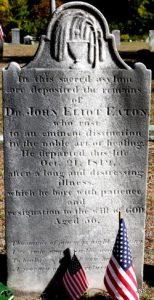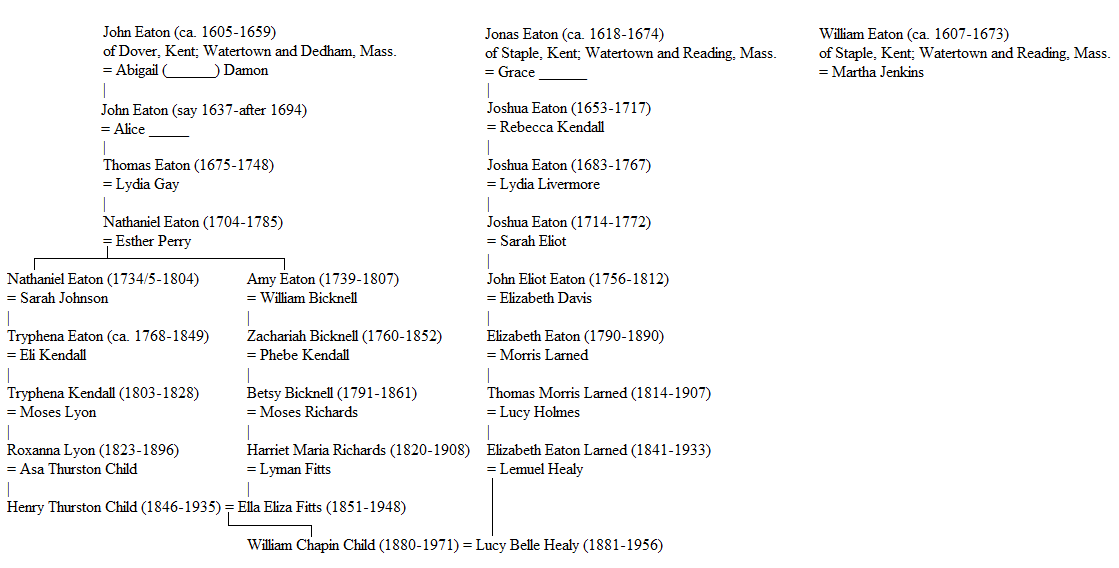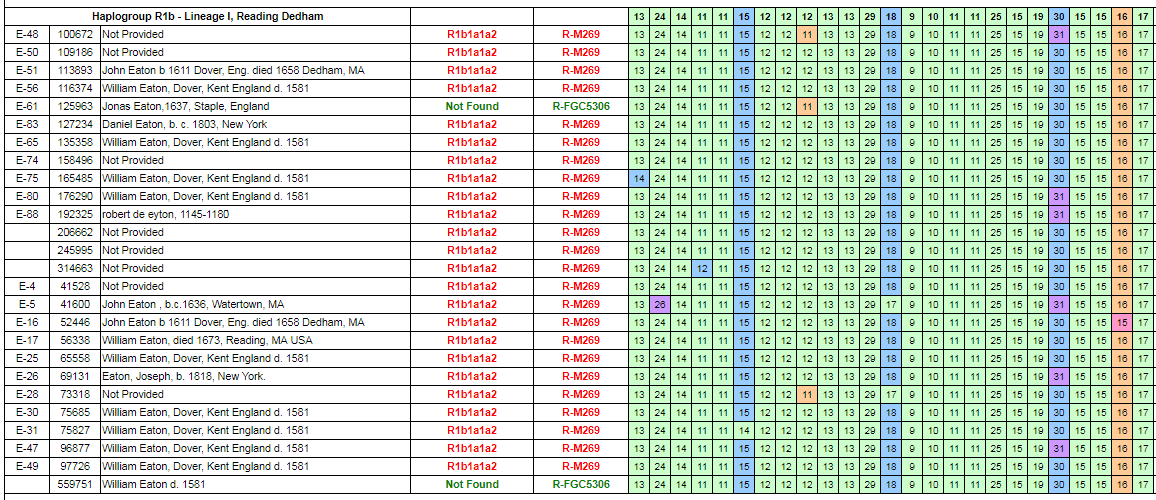
After my recent post on my Eaton ancestors, my aunt e-mailed me, curious to know if “those Eatons” were related to our “other Eatons”? The quick answer is yes, but I don’t know how! Let me explain.
Through my great-grandfather, I descend (in two unique ways, including via the Eaton family of the last post), from the immigrant John Eaton (ca. 1605–1659) of Dedham, Massachusetts. Through my great-grandmother, I descend from Jonas Eaton (ca. 1618–1674) of Reading, Massachusetts (see chart below).
Here is what we know on each Eaton man.

John Eaton is profiled in The Great Migration; he married the widow Abigail (______) Damon at Dover, Kent 5 April 1630. The family emigrated in 1635 on the Elizabeth & Ann, settling first in Watertown, Massachusetts, before moving to nearby Dedham by 1637.[1]
Jonas Eaton is covered in The Granberry family by Donald Lines Jacobus. He appears on a list dated 11 May 1637 in the following context: “Wm Eaton of Staple husbandman & Martha his wife” – with children John, Martha, and Albe and servant Jonas Eaton – took passage from the port of Sandwich in Kent. Both William and Jonas appeared in Watertown as well, and they both moved to Reading where they were admitted freemen in 1653. Jacobus concluded that “Jonas was probably [the] brother of William, and was certainly not his son, as erroneously stated in the Eaton genealogy.”
Are John and Jonas (and William) related? Staple is about 14 miles from Dover, and all three men first came to Watertown within two years of each other. Parents have not been identified with proof for any of them, and no American documents have been founding stating their kinships.
However, it would appear that descendants of the three men have participated in Y-DNA testing, and … they all match! According the publicly available Eaton DNA projects y-Results, 26 men belong to this group as shown below:
All have tested at least 37 markers, and 13 have tested at 67! (For information on what that means, see here and other links provided therein.)
Now, not all of these matches are useful for my question: I’d need to contact the project administrator and see if they would forward my e-mail to the people in this group. But from the above chart, three identify as descendants of John Eaton of Dedham, one identifies as a descendant of Jonas Eaton of Reading, and one identifies as a descendant of William Eaton of Reading. (One person identifies their ancestor as “Robert de eyton, 1145-1180,” certainly in part based on the erroneous English ancestry given in the 1911 Eaton genealogy.)
However, the largest group, ten men, identify their ancestor as “William Eaton, Dover, Kent, England, d. 1581.” This man is alleged without full proof (somewhat via the same genealogy and, more specifically, through not-fully-documented online trees) as the common grandfather of John, Jonas, and William – Jonas and William being brothers and John their first cousin, in this unproven scenario – so we can’t tell from this list alone from which of the three Eaton immigrants any of these ten descend.
[The] largest group, ten men, identify their ancestor as “William Eaton, Dover, Kent, England, d. 1581.”
With regard to the one who lists William of Reading, this brings up an interesting point in terms of how Y-DNA-tested participants identify their patrilineal ancestor. As Jacobus pointed out above, the 1911 Eaton genealogy erroneously identified Jonas as the son of William, while Jacobus thought they could be brothers. While William Eaton of Reading certainly has numerous male-line descendants, could the self-identified William descendant actually descend from Jonas, going off the 1911 error? Possibly, and thus a 107-year-old debunked kinship lives on!
Still, with at least one Jonas descendant matching to at least three John descendants, I think the Y-DNA evidence makes it very likely that my ancestors John and Jonas Eaton are of some near agnate kinship (and probably amongst the ten described above). John and Jonas were both first seen living near one another in Kent, and both first settled in Watertown. They could be first cousins, as many trees suggest, or brothers, or uncle and nephew, etc.! Are they related? Yes, but I’m not sure how!
Note
[1] For descendants of John Eaton of Dedham, see John Eaton Alden’s study in the Dedham Historical Register, 11: 67-80, 111-26, 12: 10-20, 43-54.

Brilliant!
I wasn’t aware DNA could go back 11+ generations unless all tested had the surname ie Eaton. That 5 generations was as far as DNA can be used as proof. And you need a large dna circle for that.
The dna from my gr gr grandfather & his brother have 8 who have tested, ( 3 from my side, 5 from the brothers) We are trying to prove the brothers gr grandmother’s parents. We know the line as its been published in a genealogy which also has my grandfather’s birth in 1880. But the Wethersfield church records which have all her sibs, has the page torn in half when she was born.
The 8 of us have many matches to proven siblings of this gr grandmother. Plus many matches to this gr grandmother’s grandparents. Plus the naming pattern of the children couldn’t match any better. And her surname was the only one in the town they lived.
Yet, the expert who looked at this dna said it didn’t prove a thing…..
Mayflower & DAR now have protocols for using DNA & Mayflower is in the talking stage of all prospective members doing dna tests.
Guess I just don’t understand the rules…
.
Mr Child is referring to y-DNA which is passed from father to son only and mutates very little over the generations. I’m guessing the DNA test you and your family have taken is at-DNA which you are correct is useful going back only 5 to 8 generations. DAR allows only y-DNA tests results in proving lineage to a patriot.
No, 3 of the 8 tested were male XY. All from my gggrandfather’s brother. But the other 5 were female autosomal (ancestry) going to the female in question’s mother or 3 of the mother’s other children.